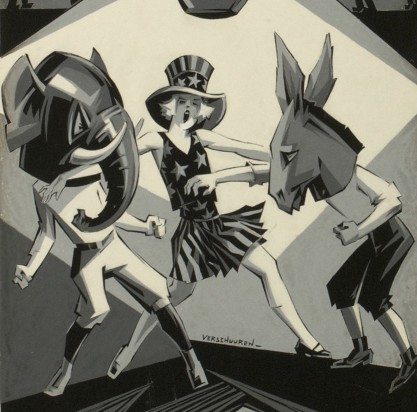

This jazz age artwork from the late fall of 1924 presents a clever satirical comment on the ongoing presidential race between incumbent Calvin Coolidge and his democratic challenger John W. Davis. With great zig zag Halloween graphics bordering a boxing ring in which the presidential contenders spar, this is a tremendously fun and art deco topical artwork. In their oversized donkey and elephant masks, being pulled apart by a flapper girl dressed as Uncle Sam, this bears a surprising similarity to today’s political theater. The bright and bold greyscale gouache used as a cover for The Brooklyn Eagle Sunday magazine. This is a spirited roaring 20s time capsule.


Charles Verschuuren (1891-1955) brought the 1920s and 30s spirit of New York to the covers of the Brooklyn Eagle’s Sunday Magazine every week from 1924 to 1933 in a dazzling, humorous style, capturing the heart of the Jazz Age. As an immigrant from the Netherlands in 1922, Verschuuren was captivated by the soaring architecture, diversity and pace of New York. His covers focused on a cast of characters headed by the newly liberated woman and her counterpart, the male collegian. The imagery deftly incorporated these characters and the feeling of America through scenes of sports, holidays, historical events, and popular entertainment. Through Verschuuren’s illustrations, Eagle readers were able to share in his wonderment and humor of urban life as he became a New Yorker.
Today’s viewers continue to be enchanted by his nostalgic Art Deco iconography. Verschuurens work has been displayed both here and abroad, his posters and drawings exhibited in the collections of the Stedilijik Museum, the Netherlands Theatre Institute, and in a traveling exhibition of war images organized by the International Foundation for the Injured and Prisoners of War. In New York, his work was seen at various venues, from Columbia University, to the Independent Artists Show at Grand Central Palace, to the Maurel Gallery alongside works by Degas, Monet and Everett Shinn. While working for the U.S. Photographic Center in Long Island City, he befriended fellow New York artist Charles Addams. The editors of the Brooklyn Eagle, which Joseph Pulitzer wrote was “one of the foremost newspapers in the nation” saw in Verschuuren an amazing talent that captured the changing face of America during the Jazz Age.
